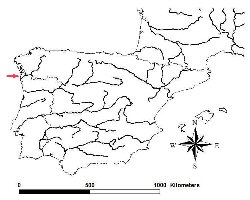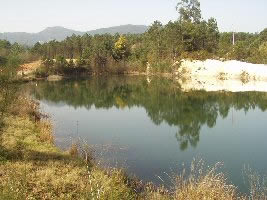|
IUCN/SCC Otter Specialist Group Bulletin
©IUCN/SCC Otter Specialist Group
Volume 26 Issue 2 Pages 65 -
131 (October 2009)
Citation: Ayres, C. and García, P. (2009). Abandoned Clay Mines: An Opportunity For Eurasian Otters In NW Spain. IUCN
Otter Spec. Group Bull. 26 (2): 67– 72
Previous | Contents | Next
Abandoned Clay Mines: An Opportunity For Eurasian Otters In NW Spain
César Ayres1 and Pablo García2, Valentín Arévalo2 and Isabel Mateos3
1ROAGA. Centro de Investigación e Información Ambiental. Estrada PO-546 Pontevedra-Marín, km. 4. Apdo.127- C.P. 36080. Lourizán, Pontevedra, Spain.. e-mail: cesar@herpetologica.org
1C/ Núñez de Zamora, 12-14; 1ºD. 37003. Salamanca, Spain. |
  |
Abstract: The Eurasian
otter (Lutra lutra) is widely distributed in the north
of the Iberian Peninsula, supposedly one of the best populations
of Spain. Usually otters inhabit coastal and riverine habitats
in this region, but in some cases they use man-made habitats.
In the last three winters the seasonal use of old clay pits by
otters has been studied in a locality from Galicia. The abundance
of these artificial habitats could lead to a recolonization of
Gandaras de Budiño and Ribeiras do Louro wetland, where
the species disappeared in the last century. |
| Keywords:
Lutra lutra, Mustelidae, clay pits, seasonal use, NW
Spain. |
| Française | Español |
INTRODUCTION
The Eurasian otter, Lutra lutra (Linnaeus, 1758), is widely
distributed in the North of Spain (Delibes, 1990; Kruuk,
1995, 2006;
Ruiz-Olmo and Delibes, 1998; Palomo
et al., 2007), and after some years
of population decline it seems that it is re-colonizing some areas
(Nores et al., 1991; Agirre-Mendi,
1998; Ruiz-Olmo and Delibes, 1998;
Lopez de Luzuriaga, 2006; Palomo
et al., 2007). The species uses all
available water bodies, and although they usually occur in coastal
and riverine habitats in the Galicia region (Callejo
Rey et al., 1979;
Callejo, 1988; Delibes, 1990; Ruiz-Olmo
and Delibes, 1998; Palomo et
al., 2007), they also use artificial water bodies (Ayres
and Garcia, 2007).
The seasonal exploitation of resources has been studied in depth in
the Mediterranean (Lizana and Pérez-Mellado, 1990; Delibes
et al., 2000; Jedrzejewska et al., 2001; Clavero
et al, 2003; 2004; 2005;
2006; 2007; García and Ayres, 2007; Remonti
et al., 2009), but
there are few studies about the feeding ecology of otters populations
in the North of the Iberian Peninsula (Callejo
Rey et al., 1979; Callejo,
1988). In this work seasonal use of artificial water bodies by otters
during winter is reported (Figure 1).
 |
| Figure
1. Iberian
Peninsula and study area (click for larger version) |
MATERIAL AND METHODS
Fieldwork was carried out in a protected wetland of Northwestern Spain,
Gandaras de Budiño e Ribeiras do Louro (GBRL), close to the
border with Portugal. GBRL has been intensely monitored since 1998,
particularly old clay pits, during a herpetological monitoring program.
After the arrival of Eurasian otter in winter 2007, specific monitoring
was performed throughout the following years. Clay pits are common
in the study area, some of them being abandoned due to end of mining
activities, and thereafter colonized by aquatic vegetation and several
animals. As the Louro River is one of the most polluted rivers in Spain
(Ayres and Cordero, 2004), clay pits represent an important resource
for endangered species such as European pond turtle (Emys orbicularis),
common teal (Anas crecca), and also provide an important breeding
habitat for amphibians.
Clay pits are variable in size, from 100 m to 500 m of perimeter,
and some of these water bodies are deep, more than 10 m in some cases.
Some of them have been colonized by aquatic vegetation, with dense
cover of Potamogeton sp., and Nymphaea alba (Figure
2).
 |
| Figure
2. Partially
naturalized clay pit (click for larger version) |
Monitoring of the presence of otters was carried out using secondary
signs (Reuther et al., 2002), mainly spraints.
The shores of the clay pits were thoroughly surveyed throughout the
year, with nearly one visit per week during the last 11 years. Spraints
were collected and analysed (Callejo Rey
et al., 1979; Callejo, 1988; Kruuk,
1995, 2006; Jedrzejewska
et al. 2001), and the biomass consumed assessed from the correction
factors in Jedrzejewska and Jedrzejewski (1998).
For further details see Ayres and Cordero (2004), Ayres
and García (2007) and García
et al., (2009).
RESULTS AND DISCUSSION
The presence of the otter was not detected until winter 2006-2007
(Ayres and García, 2007), and the species returned during winter
2007-2008, and 2008-2009. Intensive monitoring reveals that otters
frequently used GBRL clay pits during these three winters, looking
for breeding aggregations of B. bufo. More than two hundred
predated toads were found in the last three winters. The predation
pattern of toads roughly follows the “progressive skinning” described
by Slater (2002). Remains of red swamp crayfish (Procambarus clarkii)
were also found in otter spraints (n=53), as a secondary prey item
between amphibian breeding peaks. Other prey items found during spraint
analysis can be listed as accidental, with less than 1% in biomass.
The keystone role of amphibians in the otter diet has been argued by
several authors to be related to the scarcity of fish in the environment
(Lizana and Pérez-Mellado, 1990; Kruuk,
1995, 2006; Pikulik
and Sidorovich, 1996; Jedrzejewska et al., 2001; Remonti
et al., 2009)
It is remarkable that, even when centrarchid fish were available,
that they are not consumed by otters (as shown from spraint analysis),
according to the findings of Blanco-Garrido
et al. (2008). This fact
could be a limitation to the permanence presence of L. lutra in
the clay pits, as prey availability becomes low after the amphibian
breeding season, leading the animals to leave the site (Delibes
et al., 2000; Ruiz-Olmo et al., 2007).
Riparian and helophytic vegetation provides enough refuges for shelter
(an important feature for the settlement of otters; Kruuk,
1995, 2006;
Beja, 1996; Liles, 2003), and this is therefore not a limiting resource,
although the human activity could have an impact on the habitat use
by otters.
Otters leave the clay pits in March, and results support the hypothesis
that they cannot breed in the area given the absence of suitable prey
resources (a key constraint to otter reproduction; Kruuk,
1995, 2006;
Beja, 1996; Pikulik and Sidorovich,
1996; Ruiz-Olmo et al., 2001).
They therefore have to migrate to find suitable sites for rearing their
cubs.
There is an important challenge for otter conservation associated
with the management of these clay pits. As clay pits are very common
in the study area, with natural regeneration and protection, these
artificial habitats could serve as “stepping stones” for L.
lutra and other endangered species, avoiding the use of polluted
rivers, and increasing the availability of optimal habitat.
Despite this easy possibility to increase optimal habitat for many
species in the protected wetland, some clay pits have been destroyed
due to a misinterpretation of the mining law. This should be forbidden,
and a network of ponds should be kept to improve the habitat availability
in this wetland.
However, it is important to take into account that the presence of
otters in this artificial water network is seasonal and relies on the
high abundance of amphibians as an easy prey, and once this kind of
prey reaches a low abundance, otters go out from the pits. This fact
needs to be considered when working to establish otters, and the best
option is by means of habitat and prey management. Maybe, the first
option could be the management of fisheries to be friendly to otters
(Callejo, 1988; Kruuk,
1995, 2006; Beja, 1996; Polédnik et al.,
2004), by removing as far as possible feral fish and restocking populations
of autochthonous fish. This has already been done in some areas of
the Iberian Peninsula (Ruiz-Olmo, 1993).
REFERENCES
Agirre-Mendi, P.T. (1998). Distribución y
estado de conservación de la nutria eurasiática, Lutra
lutra (Linnaeus, 1758) en la Comunidad Autónoma de La Rioja. Zubia,
16: 33-59.
Ayres, C., Cordero, A. (2004). The incidence of asymmetries
and accessory plates in Emys orbicularis from NW Spain. Biologia,
59/Suppl. 14: 85-88.
Ayres, C., García, P. (2007). Depredación
de nutria Lutra lutra (Linnaeus, 1758) sobre sapo
común Bufo bufo (Linnaeus, 1758) en el LIC Gándaras
de Budino (Galicia). Galemys, 19: 45-50.
Beja, P.R. (1996). Seasonal breeding and food resources
of otters, Lutra lutra (Carnivora, Mustelidae), in south-west
Portugal: a comparison between coastal and inland habitats. Mammalia,
60: 27-34.
Blanco-Garrido,
F., Prenda, J., Narvaez, M. (2008). Eurasian otter (Lutra
lutra) diet and prey selection in Mediterranean streams invaded by centrarchid
fishes. Biol Invasions 10, 641–648
Callejo, A. (1988). Le choix des proies par la loutre (Lutra
lutra) dans le nord-ouest de l’Espagne, en rapport avec les facteur
de l’environement. Mammalia, 55: 11-20.
Callejo Rey, A., Guitián Rivera, J., Bas López, S., Sánchez
Canals, J.L., de Castro Lorenzo, A. (1979). Primeros datos sobre la
dieta de la nutria, Lutra lutra (L.), en aguas continentales de Galicia. Doñana
Acta Vertebrata, 6: 191-202.
Clavero, M.,
Prenda, J., Delibes, M. (2003). Trophic diversity of the otter (Lutra
lutra L.) in temperate and Mediterranean freshwater habitats. J. Biogeog., 30:
761-769.
Clavero, M.,
Prenda, J., Delibes, M. (2004). Influence of spatial heterogeneity
on coastal otter (Lutra lutra) prey consumption. Annales Zoologici
Fennici, 41: 551-561.
Clavero, M.,
Prenda, J., Delibes, M. (2005). Amphibian and reptile consumption
by otters (Lutra lutra) in a coastal area in southern Iberian Peninsula. Herpetological
Journal, 15: 125-131.
Clavero, M.,
Prenda, J., Delibes, M. (2006). Seasonal use of coastal resources
by otters: Comparing sandy and rocky stretches. Estuarine Coastal and Shelf
Science, 66: 387-394.
Clavero, M.,
Prenda, J., Delibes, M. (2007). Does size matter? Relating consumed
prey sizes and diet composition of otters in South Iberian coastal streams. Acta
Theriologica, 52: 37-44.
Delibes, M. (1990). La nutria (Lutra lutra) en España.
Serie Técnica. ICONA, Madrid.
Delibes, M., Ferreras, P., Blázquez, M. C. (2000). Why
the Eurasian otter (Lutra lutra) leaves a pond? An observational test
of some predictions on prey depletion. Rev. Ecol. (Terre Vie), 55: 57-65.
García, P., Ayres, C. (2007). Depredación masiva
de la nutria (Lutra lutra) sobre el galápago leproso (Mauremys
leprosa). Munibe (Suplemento), 25: 44-49.
García, P., Ayres, C., Mateos, I. (2009). Seasonal changes
in American mink (Mustela vison) signs related to Eurasian otter (Lutra
lutra) presence. Mammalia, 73: in press.
Jedrzejewska, B., Jedrzejewski, W. (1998). Predation
in vertebrate communities. The Bialoweza Primeval Forest. Springer-Verlag,
Berlin, Germany.
Jedrzejewska, B., Sidorovich, V.E., Pikulik, M.M., Jedrzejewski, W. (2001.) Feeding
habits of the otter and the American mink in Bialoweza Primeval Forest (Poland)
compared to other Eurasian populations. Ecography, 24: 165-180.
Kruuk, H. (1995). Wild otters: predation and populations. Oxford
University Press, Oxford, UK.
Kruuk, H. (2006). Otters. Ecology, behaviour and conservation.
Oxford University Press, Oxford, UK.
Liles G. (2003). Otter Breeding Sites: Conservation and Management.
Conserving Natura 2000 Rivers Conservation Techniques, Series №5, English
Nature, Petereborough, 34 pp.
Lizana, M., Pérez Mellado, V. (1990). Depredación
por la nutria (Lutra lutra) del sapo de la Sierra de Gredos (Bufo
bufo gredosicola). Doñana Acta Vertebrata, 17 (1): 109-112.
López de Luzuriaga, J. (2006). Vuelve la nutria a la
vertiente cantábrica del País Vasco. Galemys, 18: 51-52
Nores, C., García Gaona, J.F., Hernández Palacios, O.,
Naves, J. (1991). Distribución y estado de conservación
de la nutria (Lutra lutra L.) en Asturias. Ecología,
5: 257-264.
Palomo, L.J., Gisbert, J., Blanco, J.C. (eds) (2007). Atlas
y libro rojo de los mamíferos terrestres de España. DGB-SECEM-SECEMU,
Madrid.
Pikulik, M.M., Sidorovich, V.E. (1996). Seasonal prevalence
in otter reproduction and amphibian availability. Akademii Nauk Belarusi,
40(6): 80-83.
Polédnik, L., Mitrenga, R., Poledniková, K., Lojkásek,
B. (2004). The impact of methods of fishery management on the diet of
otters (Lutra lutra). Folia Zoologica, 53(1): 27-36.
Remonti, L., Balestrieri, A.,Prigioni, C. (2009). Altitudinal
gradient of Eurasian otter (Lutra lutra) food niche in Mediterranean
habitats. Canadian Journal of Zoology, 87: 285-291.
Reuther, C., Dolch, D., Green, R., Jahrl, J., Jefferies, D., Krekemeyer,
A., Kucerova, M., Madsen, A.B., Romanowski, J., Röche, K., Ruiz-Olmo, J.,
Teubner, J., Trindade, A. (2002). Surveying and monitoring distribution
and population trends of the Eurasian otter (Lutra lutra). Guidelines
and evaluation of the standard method surveys as recommended by the European
section of the IUCN/SSC Otter Specialist Group. Habitat, 12: 1-148.
Ruiz-Olmo, J. (1993).
Artificial food support for Lutra
lutra in a river in Spain. IUCN/SSC OSG Bulletin, 8: 34-36.
Ruiz-Olmo, J., Delibes, M. (1998). La Nutria en España
ante el horizonte del año 2000. Sociedad Española para la Conservación
y el Estudio de los Mamíferos, Málaga.
Ruiz-Olmo,
J., López-Martín, J.L., Palazón, S. (2001). The
influence of fish abundance on the otter (Lutra lutra) populations in
Iberian Mediterranean habitats. Journal of Zoology, 254: 325-336.
Ruiz-Olmo,
J., Jiménez, J., Chacón, W. (2007). The importance of
ponds for the otter (Lutra lutra) during drought periods in Mediterranean
ecosystems: a case study in Bergantes river. Mammalia, 71: 16-24.
Slater, F. (2002). Progressive
skinning of toads (Bufo bufo)
by the Eurasian otter (Lutra lutra). IUCN/SSC OSG Bull., 19:
25-29
Résumé : Mines
d’Argile
Abandonnees : une Opportunite pour la Loutre dans le Nord-Ouest de
L'espagne
La Loutre d’Europe (Lutra lutra) possède une
large répartition dans le nord de la Péninsule Ibérique
où elle constitue sans doute l'une des plus importantes populations
d’Espagne. Habituellement, dans cette région, la Loutre
occupe des habitats côtiers ou des rivières mais dans
quelques cas elle utilise des milieux façonnés par
l’homme. Durant les trois derniers hivers, son exploitation
saisonnière d’anciennes mines d’argile a été étudiée
dans une localité de Galice. L'abondance de ces habitats artificiels
pourrait favoriser la recolonisation des zones humides de Gandaras
de Budiño et de Ribeiras do Louro, d’où l'espèce
aurait disparu au siècle dernier.
Revenez au dessus
Resumen: Abandono
de las Explotaciones Mineras de Arcilla: una Oportunidad para la Nutria
en el No de España
La nutria euroasiática esta ampliamente distribuida en el
norte de la Península Ibérica, supuestamente es una
de las mejores poblaciones de España. Habitualmente la nutria
ocupa hábitats costeros y ribereños en esta región,
pero en algunos casos usa medios antropizados. Durante los últimos
tres inviernos el uso temporal de antiguas explotaciones de arcilla
por la nutria ha sido estudiado en una localidad de Galicia. La abundancia
de estos medios artificiales podría conducir a una recolonización
del humedal Gandaras de Budiño e Ribeiras do Louro, donde
la especie parecía haber desaparecido en el ultimo siglo.
Vuelva a la tapa
Previous | Contents | Next
|




